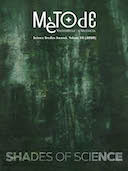The Nazi anti-urban utopia: 'Generalplan Ost'
DOI:
https://doi.org/10.7203/metode.10.13009Keywords:
Nazi Germany, Generalplan Ost, land management, colonisation, urban planning Abstract
Abstract
Nazi Germany saw Eastern Europe as an opportunity to expand its territory, its living space. Poland would become the laboratory for an inhumane colonisation plan, the Generalplan Ost (“General Plan for the East”), which involved replacement of the non-Aryan population with Germanic farmers. The anti-urban management of that lobotomised territory was scientifically drafted by a group of architects, geographers, and agronomists working under the orders of Heinrich Himmler. The urban planning aspects of this utopian plan, based on central place theory, self-sufficiency, and neighbourhood units, were of great technical interest and influenced the creation of new communities within Franco’s regime. However, we cannot overlook the fact that, had the Nazi plan been completed, it would have resulted in the forced relocation of 31 million Europeans.
 Downloads
Downloads
 References
References
Barnes, T. J. (2015). “Desk Killers”: Walter Christaller, Central Place Theory, and the Nazis. In P. Meusburger, D. Gregory, & L. Suarsana (Eds.), Geographies of knowledge and power (pp. 187–201). Dordrecht: Springer.
Dwork, D., & Van Pelt, R. J. (2008). Auschwitz. New York: Norton.
Epstein, C. (2010). Model Nazi. Arthur Greiser and the occupation of Western Poland. New York: Oxford.
Feder, G. (1939). Die neue Stadt. Berlin: Springer.
Fehl, G. (1992). The Nazi garden city. In S. V. Ward (Ed.), The garden city: Past, present and future(pp. 88–106). Oxford: Alexandrine Press.
Fritz, S. G. (2011). Ostkrieg: Hitler’s war of extermination in the East. Kentucky: University Press of Kentucky.
Hitler, A. (1936). Mein Kampf. Munich: Zentralverlag der NSDAP.
Kallis, A. (2009). Genocide and fascism: The eliminationist drive in fascist Europe. New York: Routledge.
Kay, A. J. (2006). Exploitation, resettlement, mass murder: Political and economic planning for German occupation policy in the Soviet Union, 1940-1941. New York: Berghahn.
Neupert, K. (1940). Siedlungsgestaltung aus Volk, Raum und Landschaft(10 volúmenes). Berlin: Verlag der Deutschen Arbeitsfront.
Poprzeczny, J. (2004). Odilo Globocnik, Hitler’s Man in the East. London: McFarland.
Rössler, M. (2016). Applied geography and area research in Nazi society: Central place theory and planning, 1933-1945. In P. Giaccaria, & C. Minca (Eds.), Hitler’s geographies: The spatialities of the Third Reich (pp. 182–197). Chicago: The University of Chicago Press.
Sambricio, C. (1987). Madrid, 1941: Tercer año de la victoria. In Dirección General. Arquitectura y Edificación (Ed.), Arquitectura en regiones devastadas (pp. 79–100). Madrid: Ministerio de Obras Públicas y Transportes.
Segal, S. (1942). The new order in Poland. New York: Alfred A. Knopf.
Tamés, J. (1988). Actuaciones del Instituto Nacional de Colonización. 1939-1970. Urbanismo COAM, 3, 4–12.
Downloads
Published
How to Cite
-
Abstract3395
-
PDF1222
Issue
Section
License
All the documents in the OJS platform are open access and property of their respective authors.
Authors publishing in the journal agree to the following terms:
- Authors keep the rights and guarantee Metode Science Studies Journal the right to be the first publication of the document, licensed under a Creative Commons Attribution-NonCommercial-NoDerivatives 4.0 International License that allows others to share the work with an acknowledgement of authorship and publication in the journal.
- Authors are allowed and encouraged to spread their work through electronic means using personal or institutional websites (institutional open archives, personal websites or professional and academic networks profiles) once the text has been published.





